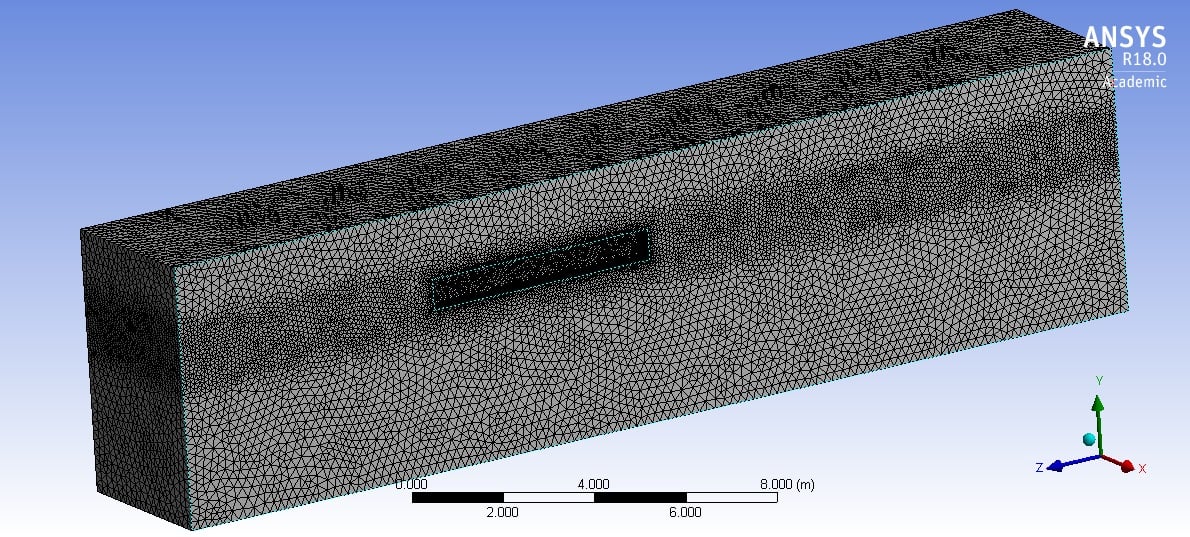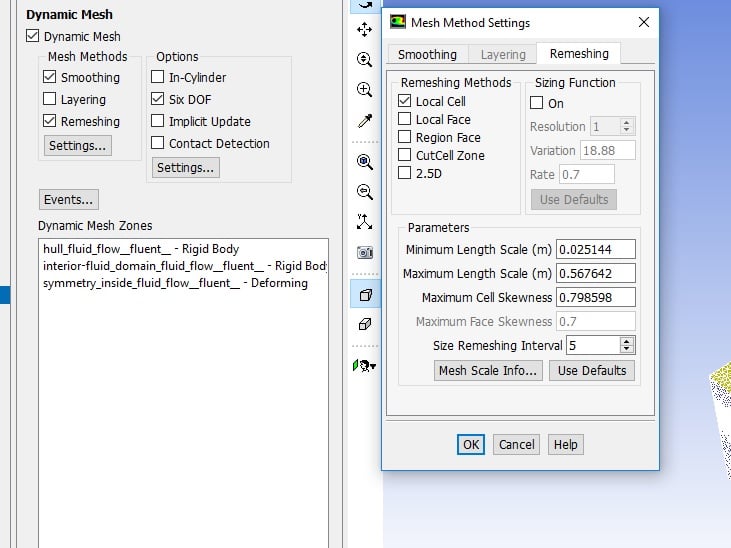-
-
June 28, 2019 at 2:35 pm
Jafar
SubscriberHello,
I k I know this has been raised several times but I reached a point where I couldn't go on anymore. I'm trying to simulate the motion of a planing hull through regular head sea waves in order to predict the heave and pitch motions. I keep getting negative cell volume error after 600 or more iterations (depending on my time step size). The geometry created is for half a hull from the transverse section. I will start from the mesh. my mesh is shown in the following figure:

Min orthogonal quality is 0.2524
Max skewness = 0.7986
Number of elements=1587073
Nodes= 279232
I created a body of influence at the water level to enhance the mesh. the mesh quality check is shown in the following pic:

My setup is created as follows:
1. VOF multi-phase with K-Omega SST viscous as shown below:

Two phase material created with primary as air and secondary as water.
My user defined function is as follows:
my dynamic mesh setup is as follows:
I have tried several setups here like diffusion, I also changed the spring constant factor to 1 or 0 but no hope.
I defined three dynamic mesh zones as follows:
1. Hull as rigid body with 6dof on ( tried to put solution stabilisation with scale factor 0.2 method: coefficient-based).
2. interiof fluid as rigid body with 6dof and passive on.
3. symmetry_inside face as deforming (shown in the following pic)
boundary conditions as follows:
I was confused what to choose for free surface and bottom level but then i understood that free surface is water level which is in my case the point of origin of the coordinate system and bottom is the bottom of the domain which is 4 m below the origin in the y axis.
outlet conditions are as follows:
the hull is a wall and the rest of the surfaces are symmetry.
solution method is as follows:

I tried other options with no hope.
I tried several time step size from 0.01 to 0.0001 with no hope.
Could you please let me know whats wrong with my simulation?
I read that I could define the moving mesh zones as user defined, could you please let me know how ?
Many thanks in advance. -
June 28, 2019 at 2:40 pm
-
June 28, 2019 at 2:45 pm
Jafar
SubscriberOne more thing, the origin of my coordinate system is at the centre of he hull (point of centre of gravity which is assumed to be the point of water surface)
-
July 1, 2019 at 4:00 pm
Rob
Forum ModeratorIf you run the model up to near the point where it fails how good is the mesh? If you've had rapid changes in hull position (ie it's bouncing) you could find the speed is too high for the time step.
-
July 1, 2019 at 4:11 pm
Jafar
SubscriberThanks for your reply. My speed is 1.044 m/s. Is it low for a 0.005 (s) time step?
Can you please let me know how to calculate my bottom level and free surface level?
At the point where it fails, I noticed that the planing hull is going down close to the bottom of the domain (it sinks) which dos not make sense and I think it might be because I wrongly defined my bottom and free surface level.
thanks again. -
March 13, 2020 at 4:28 am
surajgarad
Subscriber@Jafar
Please can you explain your udf and dynamic mesh parameters in fluent?
Email: surajk.garad101@gmail.com
-
March 13, 2020 at 5:11 am
Keyur Kanade
Ansys EmployeeFree surface level is level of water. I think in your case is 4m. So its ok.
If hull is going down then you may need to change values in your UDF. Please cross check/reduce the values in UDF.
Regards,
Keyur
If this helps, please mark this post as 'Is Solution' to help others.
Guidelines on the Student Community
How to access ANSYS help links
-
- The topic ‘heave and pitch motions of a high speed planing hull using Fluent’ is closed to new replies.



-
4618
-
1530
-
1386
-
1209
-
1021

© 2025 Copyright ANSYS, Inc. All rights reserved.
















